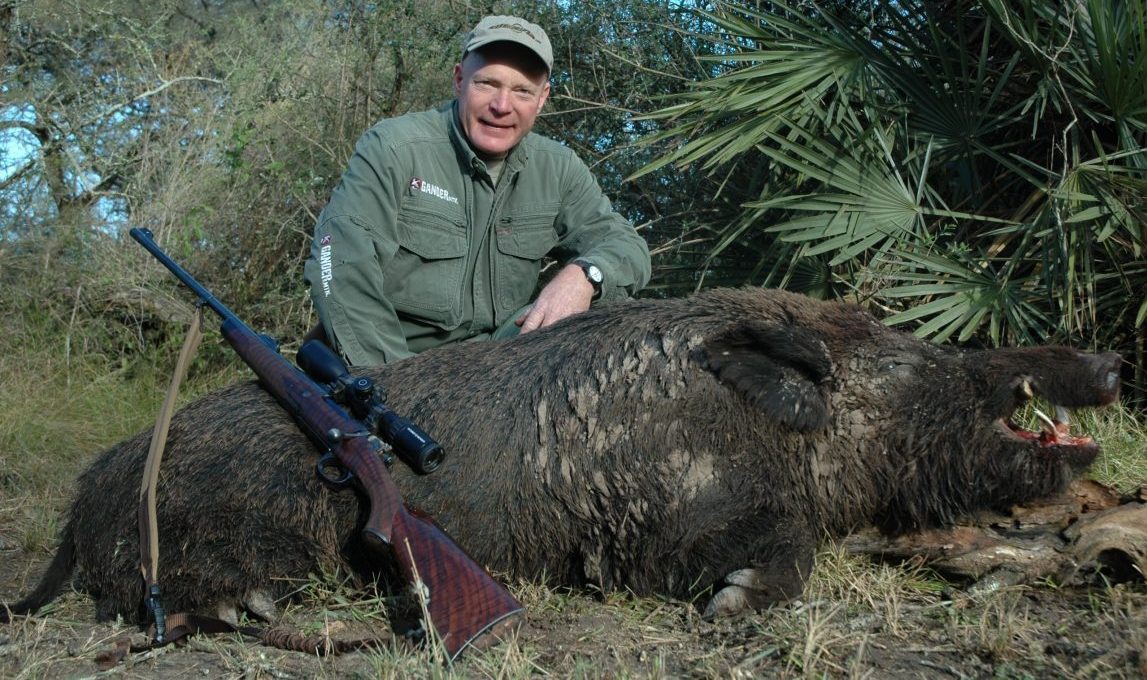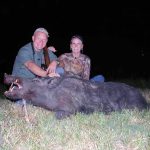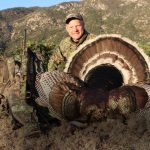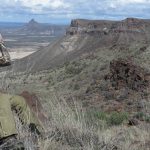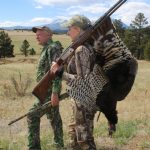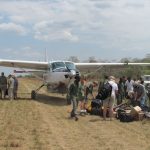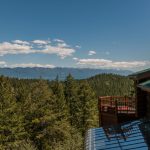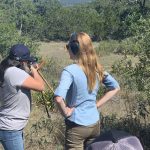If you haven’t hunted wild hogs, it’s a blast!
North America’s biggest hunting culture centers around deer, which are, for most of us, the most available and accessible large game. But the rapid expansion of feral hogs is changing this, and in some areas, already has. Our town of Paso Robles is in the center of California’s Central Coast pig population. For decades, our year-round hog hunting has seen more hunter participation than our deer season, and much greater economic impact.
Strategically situated halfway between L.A. and San Francisco, Paso Robles at its peak had twenty-some local outfitters, plus spin-off: Meat processors and taxidermists, and services such as food, fuel, and lodging. Some outfitters vanished when California’s long drought reduced hog numbers, but feral hogs are incredibly prolific. With good rains, numbers have rebounded, and we still have a solid core of local guides. Sure, they also hunt deer, tule elk, quail, and wild turkeys. However, wild hogs are the biggest draw for urban hunters looking for a getaway.

Donna Boddington with a perfect “eatin’ size” Central Coast hog, a good, fat sow. Red, brown, and black pigs are common here, but belted, spotted, and light-colored hogs are also encountered.
If you haven’t hunted wild hogs, it’s a blast! Seasons are long, bag limits are liberal and, under most circumstances, any hog is legal. At first, most hunters want a “tooth pig” with big tusks. Older boars exist in every pig population, but are a small percentage, and tend to be warier and more nocturnal than younger pigs. Honestly, chances of getting a big boar on a short hunt are not good. Experienced hog hunters often don’t look for big tuskers, because the pork from a big sow or younger boar is a lot better.
One of the downsides to California hog hunting is that, since the 1980s, our pigs have been a bona fide big-game animal. This means no baiting or night shooting, legal “methods of take” apply, and a hunting license and a tag is required for every pig. Not a big deal for residents, but for the out-of-staters that visit local outfitters the nonresident hunting licenses and tags (per pig) are pricey. Elsewhere, this varies. As of September 2019, Texas (with 4 million wild hogs) dropped all license requirement for wild hogs–please shoot more. A “minimal” license requirement is more normal for most states with established feral hog populations. Early this year I bought a Georgia license so I could hunt hogs on a buddy’s place: A one-day nonresident license was $20, extendable for $6 a day, so a reasonable $40 for four days.
Now that I am a Kansas resident, I keep a California nonresident license and pig tag, together $254.63. That’s a big ouch to hunt a hog (just one tag, thank you!). But I pay it. I still love our Central Coast hog hunting, for decades my year-around bullet-testing laboratory. In Texas and the Southeast, much hog hunting is done from stands, over food sources (or bait). Amid our rolling ridges, hog hunting is spot-and-stalk, and a lot of fun.

Boddington and Chad Wiebe with a really good Central Coast boar. In this area the feral hogs are a mini-industry; Wiebe is just one of several outfitters in San Luis Obispo and Monterey Counties deriving much of his living from hog hunting.
Nationwide, our feral hogs are a problem. Able to deliver multiple litters per year, increase and expansion can be exponential. One estimate suggests a population of 9 million feral hogs, with sightings in all of the lower forty-eight states, and annual agricultural damage exceeding $2 billion. My friend Zack Aultman has a pine plantation in southern Georgia, awesome for whitetails, turkeys, and hogs. Feral hogs have probably been present since the Civil War, and there were pigs when I first hunted there a dozen years ago. Back then, sightings were infrequent; just a few dozen were taken annually, mostly incidental to deer hunting. This continued for a while, and then hogs got out of hand. Zack keeps records; in recent years the harvest has exceeded a thousand, with little indication numbers have been reduced.
Our California feral hogs have also been present for decades. For sure they do damage. Barley is a common dry-land crop here; when the barley ripens in late spring, a herd of hogs can destroy a field overnight. However, it seems to me our hogs are somewhat self-regulating because of periodic drought. Fifteen years ago, before a long drought, we could glass from a high point at dawn and watch hundreds of pigs streaming up out of valleys, moving toward bedding cover in the chaparral ridges. Through ten dry years we could still find hogs—but numbers were obviously down. With recent rains they’re coming back, but today we still have to hunt much harder than in years gone by.
Our California hogs have been big-game animals for decades. In our area, perhaps uniquely, feral hogs are a resource as much as a pest. Here, in parts of Texas and the Southeast, and in various other parts of the world, including Argentina and Australia, feral hogs are or are becoming the most numerous, available, and accessible game animals. In the Western Hemisphere, and in the South Pacific, we’re dealing with feral hogs, essentially a non-native invasive species, with unknown long-term effects on native fauna and flora.
In Europe, and on through Asia, the pigs are mostly the real deal: the Eurasian wild boar. Feral hogs, domestic swine, and the Eurasian wild boar are conspecific, lumped together as Sus scrofa. All of these interbreed freely, but the true wild boar has specific characteristics: Tall and humped at the shoulder, sloping down to hams, with an erect mane of stiff bristles. Color varies, but vari-colored hair is common, and piglets are striped. It seems to me pure Eurasian is a very dominant strain. Here on the Central Coast, William Randolph Hearst introduced pure European blood nearly a century ago. Our feral hogs run the gamut: Black, brown, red, spotted, belted, but we see some hogs that still look very much like the real thing. Pure European blood has also been introduced in other areas. It’s apparent and can be readily seen in the Texas Hill Country, but pigs I’ve hunted in Florida, Georgia, and other parts of Texas seem obviously plain old feral hogs.

The various Old-World races of Eurasian wild hog vary in size, but food, and climate have great influence. Donna Boddington with an awesome boar from Turkey, always one of the great places to find really big pigs.
This may be based primarily on climate and food, but it seems to me feral hogs are more prolific than true wild boars. Even so, the Eurasian wild boar is the world’s most widespread large mammal. Extinct in the British Isles for 800 years, park escapees in central England started re-establishing in the 1970s. As we have learned in North America, once a breeding population of hogs gets started, they’re almost impossible to get rid of. From Continental Europe eastward to China and Siberia, on east to Japan, Formosa, and Indonesia—and south to North Africa—the wild Eurasian boar exists in about sixteen subspecies. Size varies depending on race and conditions. In Western Europe the biggest boars might weigh 200 kilos (440 pounds). The largest races occur in northeastern Asia, where boars up to 350 kilos (770 pounds) have been recorded.
The biggest pigs I’ve encountered have been in Turkey. Central Asia is also known to have very large pigs. Throughout this region this is partly because the primarily Muslim population leaves them alone. Unmolested, boars grow to full potential. In heavily populated Europe, the wild boar is a major management issue. For many European hunters, the wild boar is the most plentiful and available game animal, pursued avidly, though often as a matter of necessity rather than sport. Crop damage from pigs is a significant problem, with the solution quite different from the way we handle things in North America. In Europe much available hunting land is leased, sometimes to individuals but often to groups or local hunting clubs. A common nuance to a European hunting lease is the leaseholders are liable for local agricultural damage! Harvest goals must be met, and better be right.
Depending on situation and time of year, Europeans do a lot of pig hunting from stands, over bait or feeding areas. To some extent, America’s feral hogs are throwing our traditional concept of “legal shooting hours” out the window. In California, with our pigs full-fledged game animals, we observe shooting hours. In other states, where controlling feral hogs is a goal, night shooting is often done. Shooting hours are rarely observed in Europe, although a common rule is “natural light.” A lot of European pig hunting is done by moonlight. In winter, add snow to moonlight and it’s not too difficult to pick out the burly profile of a big boar.

Whether hunting over bait or feeding areas or during drives, most European hog hunting is done from elevated stands, in part to increase safety and ensure shots are directed down into the ground.
Selective hunting for boars, however, has little influence on pig populations. So, over there, the traditional driven hunt is the primary means for achieving management goals. Many of these are small affairs; in Estonia I hunted with a local club that does limited drives almost every Saturday. A one-day bag may be small, but by staying at it, they achieve their management goals. Other drives are large, well-organized affairs; I attended one in Germany that had more than seventy “guns” and a couple hundred drivers or “beaters.” Large drives like this are essentially “cleanup.” Pigs may not be the only authorized species, but a primary goal is usually to achieve the harvest goal on hogs to reduce crop depredation and avoid overpopulation. Over here and over there, pigs are a management challenge, and an increasingly important game animal.

